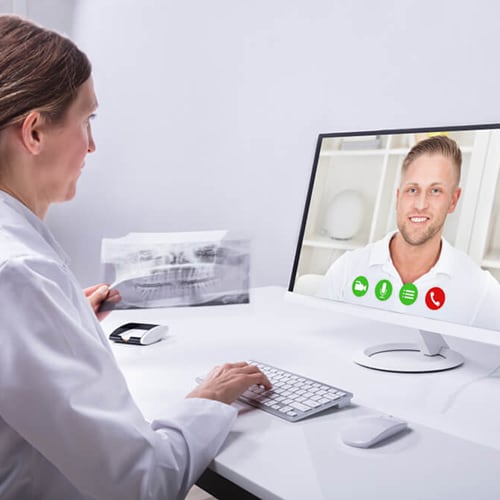Advances in communication technology now offer dentists a new tool for delivering care: teledentistry. The American Teledentistry Association defines this method as "the use of electronic information, imaging and communication technologies ... to provide and support dental care delivery, diagnosis, consultation, treatment, transfer of dental information and education." This new way of reaching patients comes with a few considerations.
How It Works
There are two ways to deliver virtual care: real-time consultation or the store-and-forward method. In both situations, a licensed dental professional in one location communicates remotely with a patient in another location. The American Dental Association refers to these two methods in its teledentistry guidebook as synchronous and asynchronous.
Real-time (synchronous) consultation functions much like a video chat service, with a feed that is live and happening in real time. The store-and-forward (asynchronous) method is used when information is gathered on location by an assisting dental professional and then reviewed later by a dentist. Radiographs and intraoral photos may fall under this latter method for diagnosis or treatment planning.
Expanding Access to Care
The possibility of virtually bringing specialists and general providers into remote areas is important for patients living there who have limited access to care. Someone in a rural setting, for example, would no longer need to make a trip to receive an initial diagnosis or in some cases to return for follow-up if they could discuss this virtually with their dentist and send an image over the internet.
Associated Costs
For a dental practice, remote consultation may not be noticeably more cost-effective than ordinary in-person care. For the patient, however, eliminating the need to travel or take as much time off from work could greatly reduce costs. A study of residential aged care facilities, published by the Journal of Telemedicine and Telecare, suggests the cost of remote appointments is lower than or equivalent to current standards when asynchronous teledentistry is provided. However, in this analysis, synchronous teledentistry was slightly more expensive than face-to-face treatment. The researchers acknowledge that the appropriate situations for remote appointments and in-person care may differ.
Paying Practitioners
There are no well-established norms for paying practitioners for remote care, and each part of the world regulates this treatment method differently. Guidelines for how much providers should charge and how much they are reimbursed by a national health program or an insurance company have yet to be established in many areas.
Privacy and Legality
Teledentistry is not without its concerns. Telehealth services have to make sure they secure record keeping and privacy of information. Dentists must have thorough computer knowledge to practice remotely so that they can secure patient health information with methods like online encryption and password protection. Any technology used for a remote consultation must also be compliant with regional laws that protect patients' privacy. In addition, there may be legal considerations in the practice of teledentistry itself.
It may not be the right decision for your practice, but international adoption suggests teledentistry is here to stay. More research is needed to determine how this tech-savvy method can fit into current methods of treatment and meet patients' needs.


Was this article helpful?
If you’d like a response, Contact Us.